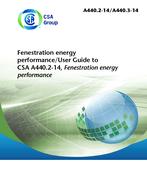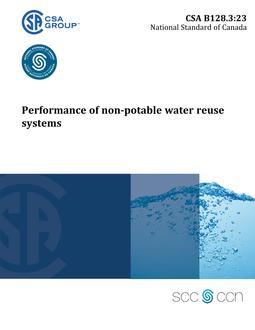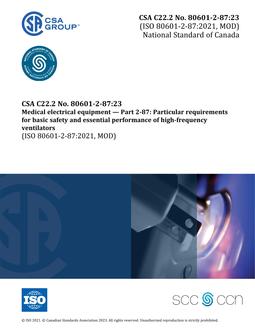
CSA A440.2-14/A440.3-14 (R2018)
Preface
This is the sixth edition of CSA A440.2/A440.3, Fenestration energy performance/User guide to CSA A440.2-14, Fenestration energy performance. It supersedes the previous editions published in 2009, 2004, 1998, 1993, and 1991 under the title Energy performance of windows and other fenestration systems (and associated user guides). CSA A440.2 applies to the determination of energy performance properties for a variety of fenestration systems, including fixed windows, operable windows, sliding glass doors, hinged doors, skylights with flat glazings, and curtain walls. It includes the following energy performance properties, which are applicable to all building types (residential, commercial, and other): (a) overall coefficient of heat transfer (U-factor); (b) solar heat gain coefficient (SHGC); and (c) visible transmittance (VT). These properties, along with a visible transmittance, can be evaluated using either computer simulation or measurement. In addition, CSA A440.2 provides a means for determining a comparative Energy Rating (ER) for fixed and operable windows, sliding doors, and hinged doors to be used in low-rise residential housing. The ER combines the U-factor, SHGC, and heat losses resulting from air leakage into a single rating that allows the energy performance of fixed and operable windows, sliding doors, and hinged doors to be compared over an average heating season. Assumptions have been made about the size of the fixed and operable windows, sliding doors, and hinged doors in order to develop the ER. CSA A440.3, the user guide to CSA A440.2, has been prepared to explain the content and use of CSA A440.2. CSA A440.3 allows the knowledgeable user to develop specific energy performance properties that apply to fenestration systems of different sizes in specific geographic locations and orientations. CSA A440.3 is divided into three parts. In Section I, the energy performance of fenestration systems is discussed in general terms to provide an overview of the issues that should be considered in the selection of fenestration systems. Section I also explains some of the content of CSA A440.2. In Section II, technical explanations are provided for specific clauses of CSA A440.2. In Section III, the concepts of Specific Energy Rating (ERS) and Energy Rating for the cooling season (ERC) are explained for more advanced users. CSA acknowledges that the development of these Standards was made possible, in part, by the financial support of Natural Resources Canada (NRCan). A440.2-14 – Fenestration energy performance
Scope
1.1 This Standard applies to (a) fenestration systems covered by AAMA/WDMA/CSA 101/I.S.2/A440, including (i) vertically sliding windows; (ii) horizontally sliding windows; (iii) dual-action windows; (iv) casement windows, both fixed and operable; (v) projecting (awning/hopper) windows; (vi) fixed windows; (vii) sidelites; (viii) transom windows; (ix) sliding glass doors; (x) side-hinged doors; (xi) dual-action side-hinged doors; (xii) architectural terrace doors; (xiii) unit skylights and roof windows; (xiv) greenhouse or garden windows; and (xv) tubular daylighting devices; and (b) curtain walls. Note: Unless otherwise specified, the term “fenestration system” is used to apply to all products listed in Clause 1.1. 1.2 This Standard specifies both measurement and calculation methods for establishing the following fenestration system properties for both residential and commercial applications: (a) overall coefficient of heat transfer (U-factor); (b) solar heat gain coefficient (SHGC); and (c) visible transmittance (VT). This Standard also specifies measurement methods for establishing the Temperature Index (I) for fenestration systems for both residential and commercial applications. Note: The fenestration properties established in accordance with this Standard are for specific indoor and outdoor conditions and will vary slightly under actual conditions. The values obtained by the methods specified in this Standard are considered to provide an acceptable basis for comparing performance in use. 1.3 1.3.1 This Standard specifies a method for determining an energy performance rating for vertical fenestration systems, under heating conditions, for use in low-rise residential applications. The Energy Rating (ER) includes factors for (a) solar heat gain; (b) heat loss by conduction, radiation, and convection; and (c) heat loss by air leakage. 1.3.2 The ER allows for a comparison of different fenestration systems on the basis of their effect on the energy supplied annually by the heating system. The ER calculation assumes vertical installation in low-rise residential buildings and is based on average conditions for (a) incident solar radiation on fenestration systems facing the four cardinal compass directions (north, east, south, and west); and (b) representative climate zones in Canada. 1.3.3 The ER should not be used to rate (a) any sloped glazing (residential or commercial); or (b) fenestration products that will be installed in commercial, industrial, or high-rise residential buildings. 1.4 CSA A440.3 is a user guide to this Standard. It provides guidance on determining (a) a specific Energy Rating (ERS) for particular locations, orientations, and vertical fenestration system sizes; and (b) an ER for residential cooling (ERC). 1.5 This Standard does not apply to (a) fixed glazing cast into precast concrete panels; (b) overhead doors; (c) revolving doors; (d) doors intended for indoor use; and (e) storm doors. Note: While these products have not been considered in the development of this Standard, simulation procedures given in the Standard may be used to evaluate the U-factor and the SHGC of these products. 1.6 This Standard does not address the retention of thermal and optical properties and airtightness by fenestration systems over time and under conditions of use. 1.7 In CSA Standards, “shall” is used to express a requirement, i.e., a provision that the user is obliged to satisfy in order to comply with the standard; “should” is used to express a recommendation or that which is advised but not required; and “may” is used to express an option or that which is permissible within the limits of the standard; and “can” is used to express possibility or capability. Notes accompanying clauses do not include requirements or alternative requirements; the purpose of a note accompanying a clause is to separate from the text explanatory or informative material. Notes to tables and figures are considered part of the table or figure and may be written as requirements. Legends to equations and figures are considered requirements. Annexes are designated normative (mandatory) or informative (non-mandatory) to define their application. ———————————————————————————- A440.3-14 – User guide to CSA A440.2-14, Fenestration energy performance Section I – Understanding fenestration energy performance I.1 Purpose of CSA A440.2 I.1.1 CSA A440.2 was developed to allow comparison of the energy performance of different fenestration systems. In the past, the energy performance information provided by the manufacturer was often limited to the R-value or the U-factor for the centre-of-glass area. Because the effects of the frame and sash were not taken into account, the energy performance of the fenestration system was usually overrepresented. CSA A440.2 specifies a procedure for evaluating the energy performance parameters of the total fenestration system, including the glass, frame, and sash. I.1.2 The properties that affect the energy performance of fenestration systems are (a) solar heat gain; (b) heat losses resulting from conduction, radiation, and convection; and (c) heat losses resulting from air leakage. CSA A440.2 provides methods for determining the solar heat gain coefficient (SHGC) and the heat losses resulting from conduction, radiation, and convection (U-factor). The procedure for determining air leakage is specified in AAMA/WDMA/CSA 101/I.S.2/A440. I.1.3 CSA A440.2 also provides a method for calculating the overall Energy Rating (ER) for a fenestration system to be used in a self-contained low-rise residential building by combining, into a single overall rating, the following three properties: (a) solar heat gain coefficient (SHGC); (b) overall coefficient of heat transfer (U-factor); and (c) air leakage. The ER provides a means to compare the energy performance of fenestration systems used in low-rise residential buildings. However, because of the manner in which the ER is determined, there are limitations to its applicability. As explained in Clause I.6, ER is only applicable when comparing fenestration systems that are to be used in houses under heating conditions.
Product Details
- Edition:
- 6th
- Published:
- 01/01/2014
- ISBN(s):
- 9781771393935
- Number of Pages:
- 132
- File Size:
- 1 file , 3.4 MB
- Product Code(s):
- 2422765, 2423096, 2422765


